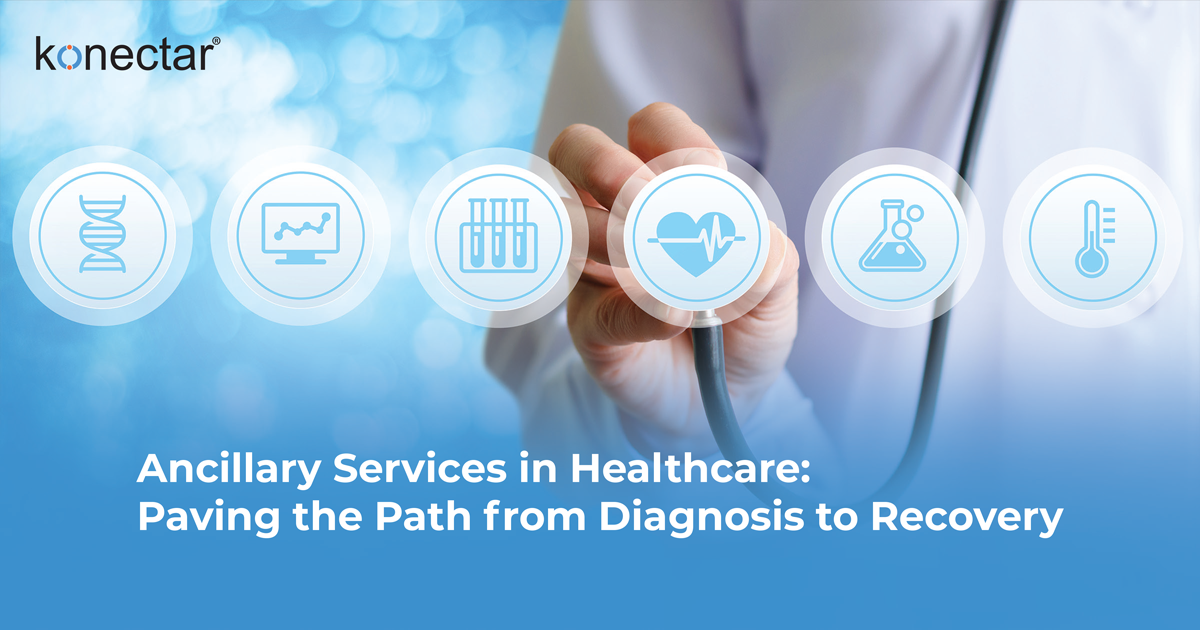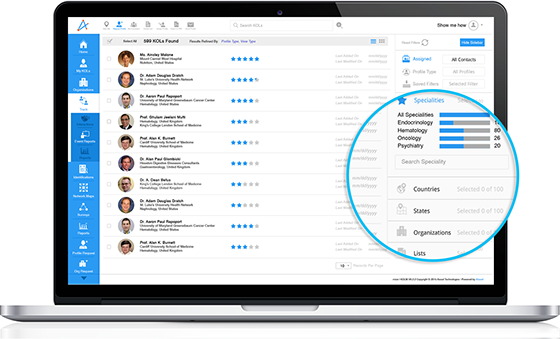1 Dec 2023
Paving the Path from Diagnosis to Recovery with Ancillary Services

Ancillary services are crucial for supporting the efforts of healthcare professionals, including physicians, nurses, and dentists. From initial diagnosis to recovery, these services address the diverse needs of patients and provide comprehensive healthcare that contributes to their overall well-being and satisfaction.
In this article:
What are Ancillary Services in Healthcare?
Ancillary services meaning denote support services or procedures that supplement the primary medical care. This includes Diagnostic services ( Blood Tests, Cardiac Monitoring, Laboratory Tests, Radiology/Diagnostic Imaging, Genetic Testing, and Telemedicine); Therapeutic services (Occupational therapy, Dialysis, Speech therapy, Physical Therapy, Ventilator services, wound care, and Chiropractic services) and Custodial services ( Care Delivery, Medical day care, Nursing homes, and Home healthcare). These services contribute to comprehensive patient care and treatment.
The Importance of Ancillary Services
-
Enhanced Patient Care
Ancillary services enhance Patient Care by providing additional support and resources such as counseling, wellness programs, and follow-up care, ensuring a more comprehensive and holistic approach to healthcare. By addressing various aspects of a patient's well-being, these services contribute to improved overall health outcomes and patient satisfaction.
-
Diagnostic Precision
Ancillary services, such as advanced imaging technologies and laboratory innovations, significantly contribute to diagnostic precision. These services provide detailed and accurate information, helping professionals in making informed decisions about a patient's condition. Diagnostic precision is essential for early detection of diseases, guiding the development of targeted treatment plans and improving the chances of successful outcomes.
-
Treatment Support
These services offer vital support to treatment plans. For example, technologies like Digital Health platforms and wearable health devices facilitate ongoing monitoring of patients, allowing healthcare providers to track treatment progress remotely. This real-time data assists in adjusting treatment strategies as needed, ensuring that interventions are tailored to individual patient responses and promoting the effectiveness of therapeutic measures.
-
Efficient Workflow
They contribute to a more efficient healthcare workflow. Digital health platforms streamline communication between healthcare providers, ensuring timely access to diagnostic results and patient information. This efficiency is particularly valuable in emergency situations and for coordinating care among multiple HCPs (healthcare professionals), ultimately improving the overall quality and speed of healthcare delivery.
-
Community Health Improvement
These services are accessible and responsive to community needs. They play an important role in improving overall community health. Services such as health education, preventive screenings, and community outreach contribute to health promotion and disease prevention. By addressing healthcare at the community level, these services contribute to reducing health disparities and promoting the well-being of the entire population.
Technologies Shaping Ancillary Services
-
Digital Health Platforms
Digital health platforms have transformed ancillary services by introducing Electronic Health Records (EHRs), centralizing patient information for more accessible and efficient healthcare delivery. Telemedicine facilitates virtual consultations, enhancing patient-provider communication and expanding healthcare access.
Mobile health apps empower individuals to participate actively in their health management. They allow for real-time monitoring of vital signs and medication adherence. These platforms collectively streamline communication between healthcare providers, ensuring swift access to diagnostic information and enabling remote monitoring for better overall patient care.
-
Advanced Imaging Technologies
The evolution of diagnostic imaging technologies, such as Magnetic Resonance Imaging (MRI), Ultrasound and Computed Tomography (CT) scans, marks a significant advancement in healthcare diagnostics.
MRI provides detailed images of soft tissues, aiding in early detection and precise diagnosis. CT scans offer cross-sectional views, providing valuable insights into anatomical structures. Ultrasound, a non-invasive option, is widely used for various medical conditions. These advanced imaging technologies collectively contribute to more accurate and timely diagnosis, enabling Healthcare Professionals to develop targeted treatment plans.
-
Laboratory Innovations
Innovations in laboratory testing, especially in Genetic Testing and molecular diagnostics, are key contributors to the era of personalized medicine. Genetic Testing analyzes an individual's DNA, identifying genetic markers relevant to disease risk and treatment response. Molecular diagnostics explore the molecular and biochemical aspects of diseases, offering insights for targeted therapies.
Laboratories, as crucial components of ancillary diagnostic services, play a pivotal role in curating treatments based on an individual's genetic makeup. This personalized approach optimizes therapeutic outcomes.
-
Wearable Health Technologies
Wearable devices, including fitness trackers and smartwatches, contribute to ancillary healthcare services. They help to monitor vital signs and health metrics on a continuous basis. These devices enable individuals to engage in preventive healthcare measures actively. The collected data can be shared with healthcare providers for a more comprehensive understanding of a patient's health status.
-
Artificial Intelligence (AI) in Diagnostics
The application of artificial intelligence in diagnostic processes enhances the accuracy and efficiency of ancillary services. AI algorithms can analyze complex medical data, including imaging results and laboratory findings, aiding Healthcare Professionals in faster and more precise diagnosis. This technology can improve diagnostic speed and accuracy, leading to more effective treatment plans.
-
Remote Patient Monitoring
Advancements in remote monitoring technologies allow medical professionals to track patients' health status outside traditional healthcare settings. This mainly benefits individuals with chronic conditions or those recovering from surgeries.
-
Health Information Exchange (HIE)
Health Information Exchanges facilitate the secure sharing of patient information among healthcare providers. This interoperability ensures seamless communication between different healthcare entities. This leads to improved collaboration among healthcare professionals and more coordinated and efficient care delivery.
-
Telehealth Rehabilitation Services
Telehealth rehabilitation allows patients to receive therapy and rehabilitation exercises remotely, promoting continuity of care. This is especially valuable for individuals with mobility limitations or those in remote areas, ensuring they can access essential rehabilitation services.These technological advancements collectively contribute to transforming ancillary healthcare services, fostering a more interconnected and patient-centric approach to healthcare delivery.
Future Trends
-
Personalized Medicine
The future of ancillary services lies in the realm of personalized medicine. With advancements in genomics and molecular diagnostics, healthcare providers can tailor treatments to an individual's unique genetic profile, maximizing efficacy and minimizing adverse effects.
-
AI and Machine Learning
Artificial intelligence and machine learning are increasingly being integrated into ancillary services. They aid in data analysis, predictive modeling, and decision support. These technologies enhance the accuracy of diagnostics and improve treatment planning. -
Remote Patient Monitoring
The rise of remote patient monitoring devices allows medical specialists to track patients' vital signs and health metrics outside traditional clinical settings. This trend promotes proactive intervention, preventing complications and reducing the need for hospital admissions.
FAQs
-
What are the ancillary services in the hospital?
Ancillary services in a hospital refer to a variety of support services beyond standard medical care. These include diagnostic services, laboratory tests, imaging studies, and other therapeutic interventions that complement primary healthcare services.
-
What are examples of ancillary services?
Examples of ancillary services include diagnostic imaging (X-rays, CT scans, MRI), laboratory testing, physical therapy, occupational therapy, speech therapy, respiratory therapy, and pharmacy services.
-
What are the different types of ancillary services?
Ancillary services encompass diagnostic, therapeutic, and Custodial services. Common types include diagnostic imaging, laboratory testing, rehabilitation services, physical therapy, speech therapy, occupational therapy, and pharmacy services.
-
What is the role of ancillary services?
The role of ancillary services is to support primary healthcare by providing additional diagnostic information, therapeutic interventions, and support services. This comprehensive approach ensures a well-rounded and effective treatment plan.
-
What are the four ancillary providers?
Ancillary providers encompass a diverse range of services, but four primary categories include diagnostic imaging centers, laboratories, rehabilitation facilities, and pharmacies.
Conclusion
Ancillary services in healthcare are indispensable for delivering comprehensive and patient-centered care. As the healthcare landscape evolves, these services will be crucial in shaping the future of medicine.






